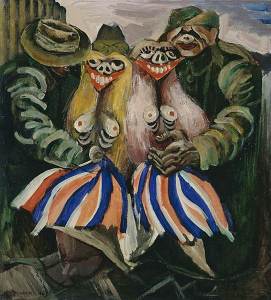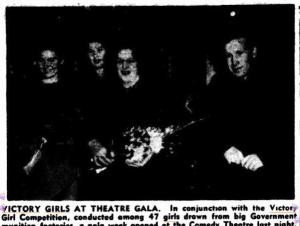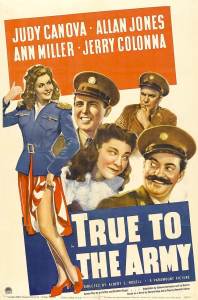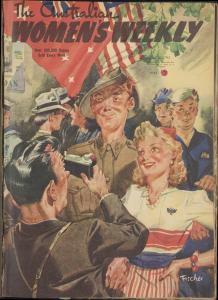It’s surprising how urban myths take hold in Australian art history. A few comments made by Albert Tucker in interviews and promotional material have convinced everyone that his iconic painting ‘Victory Girls’ (1943) is based on sexual depravity witnessed in Melbourne’s streets. I began this piece wondering whether it was possible for a painting to lie, but that turned out not to be the point. The real issue is that Tucker’s colourful anecdote (beloved of curators and journalists alike) sells short his ambition and tactical smarts as a painter.

Albert Tucker, ‘Victory Girls’, 1943, oil on cardboard, 64.6 x 58.7 cm, National Gallery of Australia, Canberra.
The initial development of the Images of Modern Evil series in late 1942 and 1943 coincided with Albert Tucker’s concerted effort to establish a distinctive and prominent position for himself within Melbourne’s artistic avant-garde. This ambition was evident in Tucker’s aggressive participation in debates on the direction of modern art, in his rise to the presidency of the Melbourne branch of the Contemporary Art Society (CAS) in July 1943, and in his bid for inclusion as a formal partner in John Reed’s publishing venture.
The Images of Modern Evil series embodied a view of the character and purpose of modern art that Tucker also articulated in print in the Angry Penguins journal and as a press spokesman for the CAS. It was a view that carefully positioned him in opposition to the socialist realism of the Left (the Communist Party-endorsed aesthetic vigorously championed by Noel Counihan) while simultaneously reining in the surrealist excesses of his CAS and Angry Penguins-affiliated peers. Tucker sought to establish a ‘third way’: a model of art proposing a new balance of the central terms in aesthetic debate—realism, the artist’s subjectivity and the social role of art—that might position him as a leading light of the artistic vanguard.
The tactical character of the Images of Modern Evil has been overshadowed by the dominant perception of Tucker as a fundamentally emotional painter. In critical and popular imagination alike, the excoriating rhetoric of the series cast Tucker as the Jeremiah of Australian art. ‘He doesn’t paint’, wrote James Gleeson, ‘he attacks. Each painting is an assault launched in rage and his target is Man’. 1
When the interpretation of the series focuses on its high emotional key, Tucker’s practice is reduced to observation and reaction. The Images of Modern Evil are addressed in terms of his responses to incidents. Even though, as Patrick McCaughey noted, Tucker’s ‘claustrophobic and brutally deracinated’ city is ‘the image of the mind as much as the image of the world’, 2 the artist is seen primarily as a witness.
Nowhere is this misleading fusion of documentary and subjective commentary more apparent than in accounts of Tucker’s Victory Girls (1943). In a 1982 interview with James Mollison, Tucker spoke of the painting as a record of wartime events in Melbourne: ‘I remember a newspaper story about girls in a back alley, with some diggers, doing a strip tease for them … All these schoolgirls from 14 to 16 would rush home after school and put on short skirts made out of flags—red, white and blue—and go tarting along St Kilda Road with the GIs and, of course, diggers.’ 3 At the same time, he admitted that the painting was highly subjective, a registration of the outrage of an ‘Edwardian puritan’ at moral depravity.
Such remarks have strongly coloured the interpretation of Victory Girls and the Images of Modern Evil series. All, it seems, were propelled by anecdote—‘American troops’, ‘night life’ and ‘sex murders’, according to John Reed, 4 or by personality—‘an angry young man obsessed with the dark bewilderment and dispossessed loneliness of urban life’. 5 But if we set aside incident and psychology, a different picture of Victory Girls emerges. Far from being a visceral and moralising reaction to wartime mayhem, it was a coolly tactical address to Melbourne’s art world. The painting is a manifesto, carefully and intelligently establishing a position for Tucker between the Socialist Realism of the Left and the romantic, surrealist-inflected art the Angry Penguins set.
The colourful legend of these mini-skirted amateur prostitutes obscures the deliberation and acuity Tucker brought to his art. The claim that Victory Girls was based on actual events has been questioned by Professor Kate Darian-Smith, whose extensive research into wartime Melbourne unearthed no evidence of ‘girls in mini-skirts with Liberty prints’. 6 Pressed by his sceptical biographer Janine Burke, Tucker admitted that he had not seen a Victory Girl but may have read about them in a newspaper. 7
Indeed there were reports of Victory Girls in the Melbourne press but they were very different from Tucker’s. From May to August 1943, female munitions workers in Melbourne participated in a Victory Girls contest. The temptations of Melbourne’s nightlife were luring women from their factories and threatening a crucial wartime industry. The Victory Girls competition awarded each factory shift points for raising money for a hostel and for reducing absenteeism; badges, pennants and cups were awarded to the individual leaders within shifts. 8 An elaborate committee structure produced precisely 47 Victory Girls, each of whom earned her status on the basis of an impeccable attendance record. 9 A photograph of members of this elite cohort reveals no blonde hair, no Veronica Lake ‘peek-a-boo’ fringes, no high hemlines and certainly no luridly striped outfits.
In any case, wartime austerity would have made all of these characteristic elements of Tucker’s Victory Girls unlikely. There was a moratorium on blonding hair, restricted colours in women’s dresses because of a shortage of dyes, and a ban on multi-coloured or fancy-worked shoes. 10 It would have been a very bold teenager indeed who ventured out into Melbourne’s highly regulated home front wearing the finery that Tucker depicted.
However the historical record clearly shows that Tucker had the spirit, if not the letter, right. If he did not actually see a teenage Victory Girl, Tucker could certainly have read newspaper reports of the exploits, if not the costume, he later attributed to them. In the first half of 1943, the press published dozens of reports of alleged moral depravity in the streets and parks of Melbourne. The Truth cited police opinion that ‘whenever allied servicemen arrive in droves, young girls appear from nowhere. One has only to roam the streets at night to see them being mauled about by men, some of whom are old enough to be their fathers’. 11 A St Kilda councillor reported that ‘Girls, evidently about 14 years of age were seen in the company of soldiers between 1 and 2 am’. 12 And a US Army colonel advised Melbournians that, ‘Your gals are developed at 15. They encourage my boys. They wait on street corners for them. They don’t seem reluctant to play’. 13
The newspapers provided the script but no illustration. So where did Tucker’s painterly imagining of the Victory Girls—those ‘footloose fillies’ in red, white and blue—come from? Perhaps Tucker ‘saw’ his Victory Girl in a poster or newspaper advertisement promoting the patriotic 1942 musical, True to the Army, starring the great tap dancer Ann Miller, which opened soon after his return to Melbourne. There in the poster for the film are the key elements of Victory Girls; the flag-striped dress, the come-hither pose, the leering soldiers crowding around the youthful Siren. Tucker may have rehearsed the motif of the sidewalk sexual assignation in The Pick-Up (1941) but Ann Miller inspired a heated, theatricalised reprise.
Lurid newspaper stories and garish movie posters return us not only to the moment of Victory Girls’s gestation in the first half of 1943, but also to Tucker’s habits as an artist. And surely the meaning of Victory Girls must lie in Tucker’s method rather than in his reminiscences or promotional spiels? The prospect of the artist using a movie, lobby card or advertisement as a source for a painting shouldn’t be surprising. In the 1940s, Tucker’s practice encompassed film, theatre and vaudeville. He had surreptitiously snapped photographs of a screening of The Grapes of Wrath in 1940, as well as designing backdrops and photographing productions for the New Theatre troupe. By 1944, a cinema façade provided a backdrop for Image of Modern Evil 6, while Image of Modern Evil 9 (along with two studies) depicted the interior of a movie theatre.
It is possible that Tucker drew on a variety of popular imagery in developing his iconography. Popular entertainment—carnivals, theatres, clowns—was a consistent motif in the Image of Modern Evil series. During World War II, mass cultural imagery, especially movies and advertising, frequently combined patriotic red, white and blue colour schemes with sexualised women and military trappings. The sheet music for Cahn and Styne’s ‘Vict’ry Polka’, published in 1943, is schematically equivalent to Victory Girls, right down to the crescent mouth motif, although radically different in mood.
And a July 1943 cover of the Australian Women’s Weekly delivered a sugar-coated version of the street encounters lamented in the yellow press.More significantly, Tucker characterised his creative process at the time as one fusing impressions of street life, emotional states and the formal development of a symbolic language. This was a working method already in place when Tucker painted The Futile City in 1940. In an unpublished statement, Tucker wrote that the painting arose from an emotional state that ‘operates as a magnet, drawing to itself appropriate material … the mood was one of depression, a sense of inadequacy while walking down a city street. There was a relaxation of conscious, focused thought, and the unwitting sensory response to the immediate environment … Under these conditions a brief image flashed involuntarily into my mind … In the process of painting it, I again reinforced the image with other appropriate images which occurred spontaneously in the process’. 14
This is a more complex and convincing account of a painting’s gestation than Tucker’s later declarations of moral outrage. Any suggestion that Tucker actually saw what he painted in Victory Girls should be set aside. But it is conceivable, given Tucker’s account of his working method, that his awareness of the changed mood on Melbourne’s may have connected with an image flashing in his mind (a movie poster or advertisement perhaps) before being consciously reinforced on canvas using a vocabulary melding Expressionism and Surrealism.
What did Tucker hope to achieve with this working method, with the invention of an image as confronting as Victory Girls? The painting was made when Tucker was deeply involved in the intricate territorial manoeuvres of the Melbourne art world. Tucker conceived of the painting, I think, as a way of declaring his position and building his reputation within that territory. It was an attempt to create an iconic art work that declared his resolution to the pressing question of art’s purpose in wartime.
Tucker had resigned from the artists’ branch of the Communist Party in 1941. He burned his final bridges in March 1943 with the publication of an attack on Stalinist aesthetics—‘Art, Myth and Society’—in the Angry Penguins journal. Conceived about the same time, Victory Girls was more than an expression of moral outrage; it was a riposte to Communist Party aesthetics. Tucker’s method was blunt. Party acolytes declared that ‘Real art has generally been closely in touch with real life, taking the struggles of the people for material and working it up with skilled craftsmanship into something that is beautiful and inspiring’. 15 Victory Girls delivered precisely the opposite: the corruption of the people, rawly presented, with no promise of redemption. The Left returned fire mechanically, condemning ‘degenerate and pretentious “angry penguins” heavily spiced with pornographic ideas’. 16
Tucker asserted the CAS principle of ‘absolute freedom’ for the Australian artist. 17 Against the demands of Communist Party solidarity, Tucker insisted on the independence of the artist: ‘a creative assertion of the result of the stimulus of his own mind and the results of his experience’. 18 That couplet—the combination of mind and experience—indicates the kind of realism Tucker had in mind. It was not the ‘coloured political cartoon’ realism of the Communist Party but neither was it shaped by a rhythm of observation and reaction, as the more emotionally oriented interpretations of Tucker’s practice suggest. 19 Tucker’s was a realism born of an emotional experience of the street but shaped into a systematically developed personal iconography addressing social experience.

Albert Tucker, ‘Victory Girls’, 1943, oil on cardboard, 64.6 x 58.7 cm, National Gallery of Australia, Canberra.
In Victory Girls and the early works of the Images of Modern Evil series, Tucker orchestrated a new mix of realism, subjectivity and social response. Nightmarish scenes and psycho-sexual drama might evoke Surrealism, but Tucker carefully plotted the degree to which he would allow that style to shape Australian modern art. In a 1940 paper to the CAS he had declared that Surrealism would only be valuable when its irrational impulses had been set aside in favour of a systematic vocabulary, rendering Surrealism rational—that is, socially purposeful. 20 The life of the unconscious could not be denied; the psycho-sexual cloud looming over Melbourne was driving the Images of Modern Evil series. But Tucker was seeking symbols that could underwrite a shared response, rather than being dismissed as one man’s foreboding. Tucker anchored his figures in Melbourne’s streets and substituted the more familiar devices of theatre (puppets, clowns, scenery flats, spotlights) for the surrealist’s language of the unconscious. Theatrical melodrama allowed Tucker to speak of social concerns without falling into the excesses of either Socialist Realism or Surrealism.
Tucker encapsulated this strategy in the idea of myth. Citing Herbert Read, he insisted on ‘the necessity for myth as a co-ordinating principle, enabling the artist to achieve an authentic integration of all those environmental, physical and mental states which culminate in the creative act itself’. 21 1943, p 54.] ‘Without such a myth’, Tucker wrote, ‘the progressive artist cannot achieve that integration between thinking, feeling and acting which is necessary for creative artistic action. 22 Here again is Tucker’s ‘third way’, an independent and subjective art which is nevertheless rooted in social experience. Myth would allow the artist to reach beyond mere social observation and avoid the cryptic extremes of Surrealism. Myth, too, would return subjective response to society as a shared symbol.
In line with this reasoning, Victory Girls synthesised social reality, the life of the psyche and wartime politics into what Tucker envisaged as ‘a fully integrated picture of reality . . . consistent with his experience’. 23 To understand the painting, and by extension the Image of Modern Evil series, merely as a symptom of the moral outrage of an Edwardian prude is to radically underestimate the artist’s ambition.
Tucker would refine his goal of a structured articulation of the role of the unconscious in art over the coming decades, culminating in a statement accompanying his exhibition at Melbourne’s Museum of Modern Art in 1960:
I am one of those that believe that consciousness is a state of latent and manifest images which are constructed from elements of this phenomenal world, and that these images stand as an allegory for the invisible and transcendental powers, for ‘mind at large’, God, or what you will: we inhabit D H Lawrence’s world of symbols. They point, to use Jung’s phrase, to something ineffable, are ‘confessions of the psyche’, a ‘testimony of the soul’.
Under formative pressures from this unseen world an image can erupt spontaneously into consciousness, ready-made like a dream, and its emergence into the phenomenal world as a physical fact depends on what our integrity, reason and will can make of it. 24
Here Tucker delivers a summation of the thinking propelling the Images of Modern Evil series. His vision of the independent artist’s voice remains powerful; modern art is not empty experiment but a ‘physical fact’ shaped by the artist’s will. Art is rooted in a world of experience consisting of both phenomenal and psychic elements. In hindsight, the best term for the ‘third way’ that Tucker sought in 1943, and for the character of the Images of Modern Evil as a whole, might be ‘Jungian realism’.
Original publication: ‘Footloose fillies and pretentious penguins: ‘Victory girls’, modern evil and the politics of the Melbourne art world’, in Heide Museum of Modern Art, Albert Tucker: images of modern evil, Bulleen, 2011, pp. 26–33. The original text has been slightly modified, for length.
- James Gleeson, ‘Tucker with Thorns’, The Sun Herald (Sydney), 2 November 1969, p 75. ↩
- Patrick McCaughey, ‘Tucker’s Images the Myths of our Art’, The Age, 21 November 1972, p 2. ↩
- James Mollison and Nicholas Bonham, Albert Tucker, Macmillan, Melbourne, 1982, pp 37–38. ↩
- John Reed, introduction to The formative years, 1940–45, Museum of Modern Art of Australia, Melbourne, 17 October – 14 November 1961, n.p. ↩
- Desmond Fennessy, ‘Towards an Ecole du Pacifique: Tucker’s Powerful Canvases’, The Age, 8 June 1957, p 18. ↩
- Albert Tucker quoted in Sandra McGrath, ‘True Oz Grit’, The Weekend Australian, 26 May 1979. See Kate Darian-Smith On the home front: Melbourne in wartime, 1939–1945, Oxford University Press, Melbourne, 1990. ↩
- Janine Burke, Australian gothic, Knopf, Sydney, 2002, p 209. ↩
- Anon., ‘”Victory Girl” Contest’, The Argus, 18 May 1943, p 6. ↩
- Anon., ‘Victory Girls to Combat Absenteeism’, The Argus, 27 May 1943, p. 6. ↩
- See ‘Editorial’, The Sun, 3 February 1943, p 4; ‘Editorial’, The Sun, 17 February 1943, p 4; ‘Fancy footwear—out!’, The Sun, 19 March 1943, p. 3. ↩
- ‘Police Raids Reveal Juvenile Immorality’, The Truth, 30 January 1943, p 5. ↩
- ‘Girls at St Kilda Criticised’, The Sun, 9 March 1943, p 10. ↩
- Anon., ‘Yanks Not “Tough” but “Woozy”; Footloose Fillies’, The Truth, 20 March 1943, p 5. ↩
- Albert Tucker, ‘The Futile City: documentary note by the artist’, undated typescript, John Reed Papers, Box 11, Folder 18, file 6B, Australian Manuscripts Collection, State Library of Victoria, MS 13186. ↩
- G. F. (George Farwell), Untitled, undated newspaper clipping. Albert Tucker papers, Box 5, manuscripts collection, State Library of Victoria. ↩
- G. F. (George Farwell), Untitled, undated newspaper clipping. ↩
- Anon., ‘Contemporary Artist Tells What It’s All About’, The Sun, 30 September 1944. ↩
- Anon., ‘Contemporary Artist Tells What It’s All About’. ↩
- The introduction to the CAS ‘Anti-Fascist Exhibition’ of 8–18 December 1942 referred to ‘Coloured political cartoons and jingo sentiment’ as a ‘cheap solution and an easy evasion of the real problem—the impact of present reality on existent artistic form’. ↩
- Richard Haese, Rebels and precursors: the revolutionary years of Australian art, Allen Lane, Melbourne, 1981, p 90. ↩
- Albert Tucker, ‘Art, myth and society’, Angry Penguins, no. 4, [March ↩
- Tucker, ‘Art, Myth and Society’, p 52. ↩
- Tucker, ‘Art, Myth and Society’, p 52. ↩
- Artist’s statement in Albert Tucker, (exh. cat.), Museum of Modern Art of Australia, Melbourne, 1960, n.p. ↩




No comments yet.